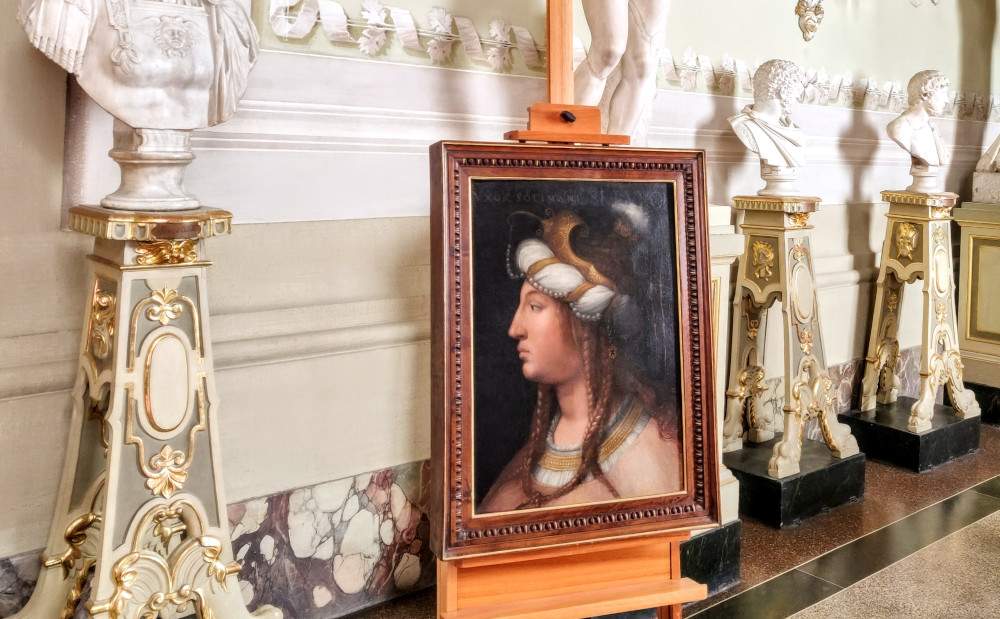At the Pitti Palace, the portrait of Ukrainian princess Roxelana will be on display until the end of the war
Starting today, a portrait of Ukrainian princess Roxelana, wife of Sultan Suleiman the Magnificent, is on display at the entrance to the Palatine Gallery of the Pitti Palace as a sign of support for the Ukrainian people and as a testimony of art against the ongoing war between Russia and Ukraine.
Created by Florentine painter Cristofano dell’Altissimo, the work belongs to the Gioviana collection of portraits of men and women who have made history, which can be seen on the walls of the corridors on the second floor of the Uffizi. "Now this painting will remain in the Palatine Gallery of Palazzo Pitti on an extraordinary basis, as a sign of closeness to the tragedy of Ukraine on the part of the Galleries. It will remain here until the end of the war," said Uffizi Galleries Director Eike Schmidt.
Of Ukrainian origin, gifted with great intelligence and charm, Roxelana was one of the most powerful women of the 16th century. Her name was Anastasia Lisowska and she was kidnapped in Lviv by Tatar raiders: taken to Suleiman’s harem, she managed to stand out among all the concubines until she became his lawful wife. Astute and ruthless, a cultured and sensitive woman, Roxelana showed great diplomatic skills, presenting herself as a mediator in relations with neighboring peoples and ensuring peace with both Poland and powerful Persia.
The name by which she was known in the West, Roxolana, or Roxa, would be derived from that by which her homeland, the province of Ruthenia in western Ukraine, then under Polish control, was referred to in the 16th century. A further hypothesis is that she was instead a maiden of the Sanseverino family, princes of Rossano (hence the name), kidnapped by privateers and given to the Turk: her “life-size” portrait is said to have been in the possession of Giovan Girolamo de’ Rossi, a 16th-century historian, who mentions her in his General History.
Herrise from slave to the Sultan’s favorite was very rapid: in 1521 she gave birth to her first male child, followed immediately by her only female child and four other males, contravening the rule that a concubine should have only one child and then follow him in assignment to the border territories, leaving the harem. So as to limit the power of concubines and the fratricidal strife that ensued upon the death of each sultan. This exception was followed by others: the marriage, which took place in a lavish ceremony in 1533 or 1534, making Rossellana the first sultan’s wife in the history of the Ottoman Empire, and later her stay in the capital at her husband’s side. She gained increasing power, ruling in Suleiman’s stead when he was away fighting and serving as a privileged informant; she had constant epistolary contact both with her husband and with other rulers, including European ones, particularly Sigismund of Poland and his son. Her good relations with the women of the Safavid sultans fostered the peace of Amasya, which marked the end of the wars between the Ottomans and ancient Persia.
Image: Cristofano dell’Altissimo, Roxelana, wife of Suleiman the Magnificent (1556; oil on panel, 60 x 44 cm; Florence, Uffizi Galleries)
 |
| At the Pitti Palace, the portrait of Ukrainian princess Roxelana will be on display until the end of the war |
Warning: the translation into English of the original Italian article was created using automatic tools. We undertake to review all articles, but we do not guarantee the total absence of inaccuracies in the translation due to the program. You can find the original by clicking on the ITA button. If you find any mistake,please contact us.




























